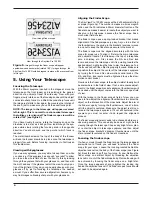
10. Loosen the black mounting plate securing knob as well as
the metal safety thumbscrew on the top of the equatorial
mount. Place the mounting plate, with tube rings attached,
in the dovetail slot on top of the equatorial mount. Position
the mounting plate so that it is centered on the dovetail
slot. Re-tighten the mounting plate securing knob until the
mounting plate is secure. Then, tighten the safety thumb-
screw. The safety thumbscrew will ensure that the mount-
ing plate (and telescope tube) will not fall off the EQ mount
if the mounting plate securing knob should come loose.
11. Open the tube rings and lay the telescope optical tube in
the rings at about the midpoint of the tube’s length. Rotate
the tube so that the focuser is at a convenient position for
viewing. Close the tube rings and tighten them.
Installing the Finder Scope
To place the finder scope (Figure 3a) in the finder scope
bracket, unthread the two black nylon screws until the screw
ends are flush with the inside diameter of the bracket. Place
the O-ring that comes on the base of the bracket over the
body of the finder scope until it seats into the slot on the mid-
dle of the finder scope. Slide the eyepiece end (narrow end) of
the finder scope into the end of the bracket’s cylinder opposite
the adjustment screws while pulling the chrome, spring-
loaded tensioner on the bracket with your fingers (Figure 3b).
Push the finder scope through the bracket until the O-ring
seats just inside the front opening of the bracket cylinder.
Release the tensioner and tighten the two black nylon screws
a couple of turns each to secure the finder scope in place.
Insert the base of the finder scope bracket into the dovetail
holder on the top of the focuser. Lock the bracket into position
by tightening the knurled thumbscrew on the dovetail holder.
Inserting the Diagonal and Eyepiece
Loosen the thumbscrew on the 1.25" adapter on the focuser
and remove the small dust cap. Insert the chrome barrel of the
star diagonal into the focuser and secure with the thumb-
screw. Loosen the thumbscrews on the diagonal and insert
the 25mm eyepiece into the focuser and secure it with the
thumbscrews.
Your telescope is now completely assembled and should
appear as shown in Figure 1.
4. Balancing the Telescope
To ensure smooth movement of the telescope on both axes of
the equatorial mount, it is imperative that the optical tube is
properly balanced. We will first balance the telescope with
respect to the right ascension (R.A.) axis, then the declination
(Dec.) axis.
1. Keeping one hand on the telescope optical tube, loosen
the R.A. lock lever. Make sure the Dec. lock lever is locked,
for now. The telescope should now be able to rotate freely
about the right ascension axis. Rotate it until the counter-
weight shaft is parallel to the ground (i.e., horizontal).
2. Now loosen both counterweight lock knobs and slide the
weights along the shaft until they exactly counterbalance
the telescope (Figure 4a). That’s the point at which the
shaft remains horizontal even when you let go with both
hands (Figure 4b).
3. Retighten the counterweight lock knobs. The telescope is
now balanced on the right ascension axis.
4. To balance the telescope on the declination axis, first tight-
en the R.A. lock lever, with the counterweight shaft still in
the horizontal position.
5. With one hand on the telescope optical tube, loosen the
Dec. lock lever. The telescope should now be able to rotate
freely about the Dec. axis. Loosen the tube ring clamps a
few turns, until you can slide the telescope tube forward
and back inside the rings. (this can be aided by using a
slight twisting motion on the optical tube while you push or
pull on it) (Figure 4c).
6. Position the telescope in the mounting rings so it remains
horizontal when you carefully let go with both hands. This
is the balance point for the optical tube with respect to the
Dec. axis (Figure 4d). If the optical tube does move, then
you must adjust the position of the optical tube in the tube
rings until it does balance in the declination axis.
7. Retighten the tube ring clamps.
The telescope is now balanced on both axes. When you
loosen the lock lever on one or both axes and manually point
the telescope, it should move without resistance and should
not drift from where you point it.
5
®
Figure 4.
Proper operation of the equatorial mount requires that the telescope tube be balanced on the R.A. axis. (a) With the R.A. lock
lever released, slide the counterweights along the counterweight shaft until it just counterbalances the tube. (b) When you let go with both
hands, the tube should not drift up or down. The telescope tube should alr4eady be balanced in the Dec. axis if you have properly centered
the 1/4" mounting block between the tube rings.
a
b
c
d




















